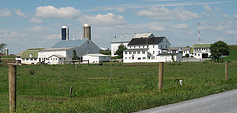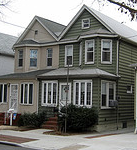
If a Single Household Loses $250,000, a Community Loses $3.3 Billion
As someone who lives in a rural community where everyone knows everyone else, I love to see people and communities prosper. In my frequent travels across the country I often find it heartbreaking to walk or drive through communities and identify all the financial drains, particularly those that could be prevented. It is a bit like watching many vats of wine in a vineyard being emptied of thousands of gallons — collected and stored over a lifetime of work — without being able to persuade the owners to turn off the spigots.
 Many Americans are unaware of how we harm ourselves with our purchase, donation and investment decisions. Moreover, we fail to notice how federal government credit, spending and regulation weave their way through communities and how this type of centralized power invisibly harms local economies. In addition, while we all use currency and credit cards, we frequently overlook their subtle consequences. This means that many of the financial forces that influence and control our lives are a mystery to us.
Many Americans are unaware of how we harm ourselves with our purchase, donation and investment decisions. Moreover, we fail to notice how federal government credit, spending and regulation weave their way through communities and how this type of centralized power invisibly harms local economies. In addition, while we all use currency and credit cards, we frequently overlook their subtle consequences. This means that many of the financial forces that influence and control our lives are a mystery to us.
As we bring light to these financial forces, we can begin to identify opportunities to protect ourselves and those we love and to help others do the same. As more people become aware of these issues and take financial action, more opportunities will open up for everyone.
Recently, I posted an example of how one hypothetical San Francisco Bay Area family is being drained by holding assets in U.S. dollars (technically, in fixed-income dollar-denominated assets). In this example, we showed how a family could lose half its purchasing power — the equivalent of $250,000 in current dollars —when measured in gas prices over a five-year period (2003 to 2008).
Now that we have described how this drain works in a single household, I have expanded the example to describe the drain in an entire community. Using the same assumptions that I used for the family that experienced a five-year $250,000 drain, I estimated that the total drain in a community of 100,000 people was $3.3 billion dollars. That is, as a result of their balances in the US dollar held from 2003-2008, the entire community lost purchasing power worth $3.3 billion in current dollar.
That’s a lot of money.
Here is breakdown of the $3.3 billion drain in this community:
- Households: $3.1 Billion
- Utility, Mortgage & Other Reserves: $25 Million
- Small Businesses: $50 Million
- Places of Worship: $8.9 Million
- Big Box and Franchise Stores: $3.5 Million
- Local Industry: $50 Million
- Hospital: $12.7 Million
- Not-for-Profits: $1.2 Million
- Clubs and Associations: $2.2 Million
- Schools and Universities: $40 Million
- Local Government: $52 Million
 My point in providing this example is to demonstrate the value that comes when our neighbors also reposition their assets and all of us collaborate on repositioning community and municipal assets. I want to emphasize that even if I and my family reposition our assets, unless the families and enterprises around us also reposition their assets, then the economy around me will be drained and could even fail. The important point to understand is that we all have a vested interest in helping the people and institutions around us successfully navigate the impacts of a falling dollar.
My point in providing this example is to demonstrate the value that comes when our neighbors also reposition their assets and all of us collaborate on repositioning community and municipal assets. I want to emphasize that even if I and my family reposition our assets, unless the families and enterprises around us also reposition their assets, then the economy around me will be drained and could even fail. The important point to understand is that we all have a vested interest in helping the people and institutions around us successfully navigate the impacts of a falling dollar.
If you read our blog or listen to our audio seminars, you are way ahead of most folks. You have or are repositioning yourselves and your family. I would like to encourage you to consider the power of organizing for financial action with your neighbors, your community and your networks. While you certainly have control over your own money, you probably also have influence with some of the people or organizations described above in your community. Why not use the knowledge and relationships you already have to raise the question: Why are we standing by while our wealth is destroyed? How can we help each other?
Why not have one or a series of potluck dinners? Invite the people in your community that you know and trust. Listen to Positioning Your Assets for Growth in Uncertain Times, print out the transcript for people to read along with the sample portfolios and charts and graphs. Talk amongst yourselves about what is happening, what it means to you and your community. Explore what actions you can take that would help each other in the short run. If there is interest, you may have the core of a Solari Circle, which is a financial action club to support your taking action as a group.
In these times, one of the most important things we can do to protect our time and resources is to help protect the time and resources of those around us. As a financial matter, we are truly in this together.
Below are our calculations on the drain in one community.
Introducing Our Community
Let’s start in a small, mythic American county in the middle of the country. We are a small county, with 100,000 people in 47,619 households (2.1 people per household), as follows:
- 300 families and individuals who are homeless
- 30,000 households who own their homes
- 17,219 who rent their homes.
 Our population has been growing steadily, with single-family homebuilding accounting for the development of a lot of farmland. However, we still have 100 small farms.
Our population has been growing steadily, with single-family homebuilding accounting for the development of a lot of farmland. However, we still have 100 small farms.
 A fair amount of our growth has resulted from retirees moving in from high cost areas on the coast. Of our population of 100,000, we have 20,000 retirees. Approximately 8,000 are dependent on social security and family support in addition to income from part-time jobs. The remaining 12,000 also have or share pensions and retirement savings, with a small number of families who are quite wealthy. These combined make up a significant portion of the individual wealth, with numerous entrepreneurs and a few hedge fund operators who maintain second homes here accounting for most of the remaining individual wealth.
A fair amount of our growth has resulted from retirees moving in from high cost areas on the coast. Of our population of 100,000, we have 20,000 retirees. Approximately 8,000 are dependent on social security and family support in addition to income from part-time jobs. The remaining 12,000 also have or share pensions and retirement savings, with a small number of families who are quite wealthy. These combined make up a significant portion of the individual wealth, with numerous entrepreneurs and a few hedge fund operators who maintain second homes here accounting for most of the remaining individual wealth.
Our Personal Financial Wealth
 We have 47,000 wage earners, with a reasonable number of households having two incomes as more incomes are stagnant or declining.
We have 47,000 wage earners, with a reasonable number of households having two incomes as more incomes are stagnant or declining.
Of our 47,219 households, in addition to their home equity and bank accounts, our investments and banking assets break down as follows:
- 50 have investments valued at $10MM or more/$500,000 banking
- 1,000 have investments valued at $1MM or more/$100,000 banking
- 2,000 have investments valued at $500-$1MM/$75,000 banking
- 6,000 have assets valued at $100-500,000/$50,000 banking
- 6,000 have investments valued at $25,000-100,000/$40,000 banking
- 6,000 have investments valued at $0-25,000/$10,000 banking
- 26,169 have no investments or savings/$1,000 banking
These current valuations reflect significant drops in nominal value as a result of recent losses in the banking and financial sectors and in the mortgage-backed securities markets as well as the general decline in the stock market.
Of these investment balances, the portion held in dollar-denominated fixed-income assets is 20% for the first group and for the other groups, 30%, 40%, 50%, 65% and 75%, respectively.
What this illustrates is that the fewer assets a family has, the higher the concentration is of dollar-denominated fixed-income assets. Thus, those who can least afford to get hurt are the ones who are being harmed the most by falling dollar. The estimated drain in purchasing value in current dollars for both investment and banking assets of households is $3.1 billion, as follows:
- 50 have investments valued at $10MM or more/$125MM
- 1,000 have investments valued at $1MM or more/$400MM
- 2,000 have investments valued at $500-$1MM/$750MM
- 6,000 have assets valued at $100-500,000/$1,200MM
- 6,000 have investments valued at $25,000-100,000/$483.8MM
- 6,000 valued at investments of $0-25,000/$116.3MM
- 25,950 households, have no investments or savings/$26.2MM
Most of these households have reserves, such as reserves for taxes and insurance escrows related to their mortgages and reserves held in the form of utility and rent deposits. To simplify things, let’s assume total reserves held for all our households are $25,000,000.
Small Business – Our Economic Engine
 Our example American county has 750 small businesses and doctor, accountant, attorney and other professional offices that have banking and dollar-denominated fixed- income brokerage assets of $50,000,000.
Our example American county has 750 small businesses and doctor, accountant, attorney and other professional offices that have banking and dollar-denominated fixed- income brokerage assets of $50,000,000.
Spiritual Practice – A Collective Financial Commitment
 We have 180 churches, five temples, one mosque and seven other places of spiritual practice or worship. Collectively the religious-sector organizations have banking assets and dollar-denominated fixed-income
We have 180 churches, five temples, one mosque and seven other places of spiritual practice or worship. Collectively the religious-sector organizations have banking assets and dollar-denominated fixed-income  brokerage assets of $4,000,000, of which $3,920,000 are dollar-denominated fixed-income assets. A handful have endowments that are controlled locally, that include primarily dollar-denominated fixed-income assets of $5,000,000. Some of the more traditional churches are part of hierarchies that have significant endowments, but while our congregations help fund them with their tithes and offerings, they are not controlled or managed here.
brokerage assets of $4,000,000, of which $3,920,000 are dollar-denominated fixed-income assets. A handful have endowments that are controlled locally, that include primarily dollar-denominated fixed-income assets of $5,000,000. Some of the more traditional churches are part of hierarchies that have significant endowments, but while our congregations help fund them with their tithes and offerings, they are not controlled or managed here.
–
–
Big Box and Franchise Stores – On the Rise
We have a growing number of big box malls and chain and franchise stores. They, however, sweep the majority of their cash balances into financial centers where it is invested globally. Their total local bank balances, primarily payroll and vendor payment float, total only $3,500,000.
Local Industry – Declining
 The number of local manufacturing, mining and food processing businesses has been declining steadily for many years. We still have a few such operations. The total industry-sector banking assets and dollar-denominated fixed-income investments at brokerage accounts are valued at $50,000,000.
The number of local manufacturing, mining and food processing businesses has been declining steadily for many years. We still have a few such operations. The total industry-sector banking assets and dollar-denominated fixed-income investments at brokerage accounts are valued at $50,000,000.
–
–
–
–
Our Hospital Grows as We Age

 Our county has one large hospital with a large payroll and a small endowment, for total dollar banking and dollar-denominated fixed-income brokerage assets of $12,650,000. Resources are increasingly strained by bad debt related to emergency services for people who do not have health insurance or who should be in assisted housing or nursing facilities but are not for various reasons, including financial.
Our county has one large hospital with a large payroll and a small endowment, for total dollar banking and dollar-denominated fixed-income brokerage assets of $12,650,000. Resources are increasingly strained by bad debt related to emergency services for people who do not have health insurance or who should be in assisted housing or nursing facilities but are not for various reasons, including financial.
–
–
–
Thriving Civic and Educational Enterprises
Our hypothetical county has a community foundation, a food bank and approximately 50 other not-for-profit organizations (not including hospitals, schools, clubs and associations), with total banking and dollar-denominated fixed-income brokerage assets of $1,200,000. As the prices of food rise, our food bank is under strain and various methods of increasing support are under discussion.
 We have several public schools, six private schools, including three Christian schools and a Waldorf school, one community college, which is a local branch in the state system and a small private university. Collectively, their dollar-denominated fixed-income bank and brokerage assets, including within several private endowments, total $40,000,000.
We have several public schools, six private schools, including three Christian schools and a Waldorf school, one community college, which is a local branch in the state system and a small private university. Collectively, their dollar-denominated fixed-income bank and brokerage assets, including within several private endowments, total $40,000,000.
We have numerous clubs and associations, including 30 women’s and garden clubs, boy and girl scouts, an optimists’ club, several volunteer fire departments, a rotary club, a chamber of commerce, various riding and sports clubs, a ranching association, 10 investment clubs, an angel network and one Solari Circle. These groups have a total of $2,200,000 dollar-denominated bank and fixed-income brokerage assets.
Our Local Government – Feeling the Pinch
 Our municipality and county maintain (i) general funds, (ii) a property tax fund, (iii) some of the school balances, and (iv) significant bond fund reserves for bonds issued to fund school construction as well as general obligation bonds issued for road and bridge construction and major maintenance and general municipal projects. We also manage significant federal grants and subsidies, including for local
Our municipality and county maintain (i) general funds, (ii) a property tax fund, (iii) some of the school balances, and (iv) significant bond fund reserves for bonds issued to fund school construction as well as general obligation bonds issued for road and bridge construction and major maintenance and general municipal projects. We also manage significant federal grants and subsidies, including for local housing, community development and war-on-drugs activities, which is a primary focus of our local sheriff and police. Total dollar-denominated and fixed-income banking and brokerage assets related to all local government accounts are $22,000,000. This balance is net of recent losses on mortgage investments made through the state short-term investment pool, including losses on interest rate swap derivatives. Property and sales tax receipts are falling, which will put pressure on our reserves, particularly our budget “rainy day” fund.
housing, community development and war-on-drugs activities, which is a primary focus of our local sheriff and police. Total dollar-denominated and fixed-income banking and brokerage assets related to all local government accounts are $22,000,000. This balance is net of recent losses on mortgage investments made through the state short-term investment pool, including losses on interest rate swap derivatives. Property and sales tax receipts are falling, which will put pressure on our reserves, particularly our budget “rainy day” fund.
Municipal and county workers and teachers are covered by a state pension fund. Dollar-denominated fixed-income investments in the fund for both retired and active workers in our municipality is $30,000,000. Because of the losses on bank, mortgage and homebuilding stocks as well as mortgage-backed securities, our contributions are expected to rise, depleting reserves.
Gambling – A Financial Drain
We made the mistake of legalizing gambling in our state over a decade ago. The lottery and gambling activities drain millions of dollars each year from the county. The balances described here would be healthier by millions of dollars if we had not done so.
The Drain Adds up to $3.3 Billion
If we add up all these balances, the dollar-denominated and fixed-income banking and brokerage assets in our county total $3.3 billion. Even though these assets have been significantly depleted recently by the various losses we have described, let’s assume that this amount has been the average between 2003 and 2008.
This means that over the last five years, when measured in current dollars, our county — citizens, enterprises, and municipality — has collectively lost $3.3 billion dollars of purchasing power as a result of a falling dollar.
This represents a significant loss of wealth; with those who can least afford to lose being the most exposed. This has devastating consequences for our Gross County Product.
This devastation will continue unless and until we reposition our thinking and our assets.
I created our new audio seminar Positioning Your Assets for Growth in Uncertain Times to help you reposition your time and assets to deal with the changes that are under way in all of our lives. Please do get it, listen and share it with those you love.
I welcome your comments if you have ideas on how I can improve or enhance this example for you and our readers. Your ideas and input are most welcome and appreciated.


